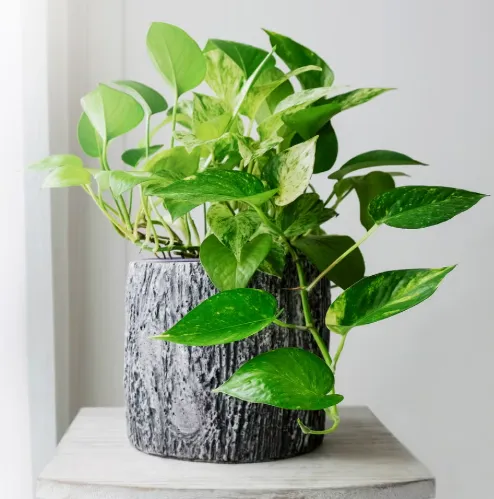The Health Benefits of Adding More Plants to Your Home: Why You Should Go Green

Incorporating plants into your living space is more than just an aesthetic choice. It has numerous health benefits that can improve your overall well-being. From enhancing the air quality to reducing stress, plants have been scientifically proven to have positive effects on both physical and mental health. In this article, we will explore six key health benefits of adding more greenery to your home and why you should consider going green.
1. Improved Air Quality
One of the most significant benefits of having plants indoors is the improvement in air quality. Plants act as natural air purifiers by absorbing carbon dioxide and releasing oxygen, which helps increase the overall oxygen levels in your home. Additionally, many plants absorb harmful toxins such as formaldehyde, benzene, and trichloroethylene, which are commonly found in household products and furniture. Plants like spider plants, snake plants, and peace lilies are known to be particularly effective at purifying the air.
2. Reduced Stress and Anxiety
Having plants in your environment has been shown to reduce stress levels. Studies have found that people who are surrounded by greenery tend to feel more relaxed, calm, and focused. The presence of plants can lower cortisol levels, the hormone associated with stress, and promote a sense of well-being. The calming effect of plants can be particularly helpful in high-stress environments like offices or busy homes, making them ideal for reducing anxiety and enhancing mental health.
3. Improved Humidity
Plants release moisture into the air through a process called transpiration. This helps increase the humidity levels in your home, which can be particularly beneficial during the dry winter months when indoor air can become very dry. Increased humidity helps prevent dry skin, respiratory problems, and irritated sinuses. Some plants, such as ferns and peace lilies, are particularly effective at increasing humidity levels.
4. Better Sleep Quality
Incorporating plants into your bedroom can promote better sleep. Certain plants, like lavender and jasmine, have calming properties that can reduce anxiety and promote relaxation before bedtime. The presence of plants can also help create a peaceful and tranquil environment conducive to better sleep. Additionally , the increased oxygen levels in the room from plants can help improve sleep quality, allowing you to rest more deeply.
5. Enhanced Concentration and Productivity
Plants in your living or working space can also boost productivity and concentration. Research has shown that people working in environments with plants tend to be more focused, efficient, and productive. The presence of greenery can stimulate creativity and improve cognitive function. This is why many offices and study spaces are increasingly incorporating plants to improve focus and motivation.
6. Natural Aesthetic Appeal
While the health benefits are significant, it’s also important to note the visual and emotional benefits of adding plants to your home. Plants bring life and color to any space, creating a more inviting, cozy, and pleasant atmosphere. The natural aesthetic appeal of plants can improve your mood and provide a sense of tranquility. They help connect us with nature, which can have positive effects on mental health.
Conclusion
Adding plants to your home or office is an easy and effective way to improve both your physical and mental health. Whether you’re looking to enhance air quality, reduce stress, or improve your sleep, incorporating more greenery into your living space offers a variety of benefits. With so many easy-to-care-for plants available, it’s easier than ever to reap the rewards of a greener, healthier home.
Comparison Table: Best Plants for Health Benefits
<table style="width:100%; border: 1px solid #ddd;">
<tr style="background-color: #f2f2f2;">
<th>Plant</th>
<th>Health Benefit</th>
<th>Care Level</th>
</tr>
<tr>
<td>Spider Plant</td>
<td>Purifies air, removes toxins</td>
<td>Low care, thrives in indirect light</td>
</tr>
<tr>
<td>Peace Lily</td>
<td>Purifies air, increases humidity</td>
<td>Moderate care, likes shade</td>
</tr>
<tr>
<td>Lavender</td>
<td>Reduces stress, promotes relaxation</td>
<td>Moderate care, needs direct sunlight</td>
</tr>
<tr>
<td>Snake Plant</td>
<td>Improves air quality, reduces stress</td>
<td>Low care, thrives in low light</td>
</tr>
<tr>
<td>Ferns (Boston Fern)</td>
<td>Improves humidity, purifies air</td>
<td>Moderate care, needs indirect light</td>
</tr>
<tr>
<td>Jasmine</td>
<td>Improves sleep, reduces anxiety</td>
<td>Moderate care, needs sunlight</td>
</tr>
</table>
Recommended Websites for Plants and Indoor Gardening:
1 The Sill - https://www.thesill.com/
2 Bloomscape - https://www.bloomscape.com/
3 Gardenista - https://www.gardenista.com/
4 Air Purifying Plants - https://www.air-purifying-plants.com/
5 NASA Clean Air Study - https://ntrs.nasa.gov/citations/20130002803
6 The Spruce - https://www.thespruce.com/indoor-plants-4127767
7 Better Homes & Gardens - https://www.bhg.com/gardening/indoor-plants/
8 Home Depot - https://www.homedepot.com/b/Outdoors-Garden-Center-Indoor-Plants/N-5yc1vZc8rx
9 Gardeners' World - https://www.gardenersworld.com/plants/
10 Healthline - Benefits of Houseplants - https://www.healthline.com/health/houseplants
By bringing more plants into your living space, you not only enhance the look of your home but also improve your health in several significant ways. From boosting air quality to reducing stress, plants are a natural and beautiful way to promote better health.






